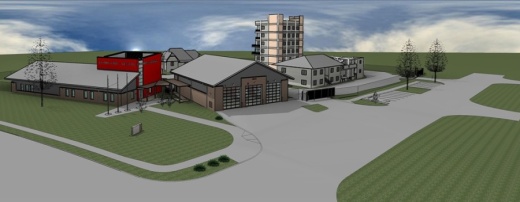The $15 million center will be located at the northwest corner of McDermott and Robinson roads immediately south of the recently completed police department substation. Firefighters will use the facilities to practice responding to real-life scenarios, such as structure fires, hazmat emergencies and rescue missions.
“We have found ourselves doing things I never would have dreamed firefighters would be doing when I got into this service back in the ’80s,” Plano Fire Department Chief Sam Greif told the Plano West Rotary Group at an Oct. 6 meeting. “These things happen, and we have to be prepared for them when they do.”
Each level of a six-story tower will represent a different environment, such as a residential high-rise apartment, a corporate office and a professional-grade kitchen, Greif said. Propane-powered fires will be accompanied by artificial smoke, he added.
“It dissipates as soon as it hits the atmosphere, but when the windows are closed it gives us the occluded vision we need to simulate what we are going to be facing in a real-world situation,” he said.
The tower will also house a basement and an elevator so firefighters can train for extractions, he added. The model home built on the property will include different roof angles and internal floor plans that pose various challenges, Greif said.
“We’ve tried to think of everything you can think of that would be a real world scenario,” he said “It will be unlike any other fire training center you’ve ever seen.”
The need for the facility was precipitated not only by Plano’s growing population but also by evolving types of occupancies, Greif said. Staff formerly used the training center at Collin College in McKinney, but that option is no longer viable due to the time it takes firefighters to get back to home base.
“There is a reason why almost every city has its own fire training center,” he said. “It would be great if you could share [this resource], but the reality is no one wants to be that far from their home and have that much difficulty getting back.”
An at-home training center will also make it easier for the department to maintain its Level 1 rating from the Insurance Services Office, which determines property insurance costs, Greif said. Response times for emergencies are also expected to improve since staff will remain inside city limits rather than traveling to McKinney for training, he added.
Above all, Greif said the training facility, which is expected to be up and running within 12 to 14 months, will equip firefighters to handle any curve ball thrown their way.
“You don't want us pulling out a book when we get there trying to figure out what it is we are supposed to be doing or how we are going to affect that rescue,” he said. “We need to have that literally as muscle memory.”






